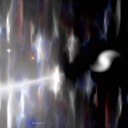
New Age music is, or was, a genre that became big in the 1990’s, and it seems to have faded now into the background of the list of genres.
But New Age is one incarnation of a larger world that includes descriptions like ambience, space music, soundscapes, among other more creative names. It grew out of a minimalist movement that went unnoticed in the 1970’s, began to appear on The Hearts of Space radio show in the 1980’s, and became the commercial music genre of New Age in the 1990’s. Or, at least, that’s my take on it.
In about 1974 I found an import record by the rock musicians Robert Fripp (King Crimson) and Brian Eno (Roxy Music) called, “No Pussyfooting.” It consisted of Robert Fripp playing sustained guitar notes with a tape loop and Brian Eno playing a sequencer-controlled synthesizer. The entire album was a kind of mantra-like drone with lead guitar passages. I was captivated. It became one of my favorite albums. I wanted to play, and create “music” like that, but I couldn’t get any one of the musicians I new interested. When I played the album for friends it was met with consternation and sometimes sarcasm. And this was the time of the original Art Music bands, like King Crimson, Yes, Pink Floyd, Genesis. But I couldn’t do it on my own, either, because it required expensive technology. In 1974, a sound-on-sound tape recorder was high technology, and synthesizers (then Arp and Moog) were as expensive as a new car.
Fripp and Eno released a similar album a few years later called, “Evening Star,” which I thought was even better than the first. If there were other artists creating this kind of music then I didn’t know about them. This was long before the Internet. In 1974 Sacramento, California was a backwater for art music. What you knew about the world was in Tower Records. And while Tower Records had an import records section, it had the small size consistent with its commercial value. I knew about Tangerine Dream, but I considered that to be a different kind of music. There was one other musician, Jon Anderson (Yes), who released an album called, “Olias of Sunhillow,” that contain deep, orchestral segments that could be called space music.
In 1982 I found an LA Times Sunday editorial about a new music with a description that reminded me of Fripp and Eno. Names were mentioned like Vangelis and Jean-Michel Jarre. In 1986 I heard the “Hearts of Space” radio show which featured what was called space music. By the early 1990’s it seemed that space music (or my name for it) had become an industry with more artist names than I can remember. This was to me a shocking development. It was rather inexplicable to me that such an arcane art form as minimalism could achieve any kind of commercial success. But the answer to the riddle was that space music really was not a success. What was popular was the New Age mind set. If you wanted to sell records you had to pretend to be a vegetarian contemplating the inner life force, or some such bull shit. What was selling records was not “The Magnificent Void,” but rather “sail away, sail away, sail away, …”
And now its over, as far as I can tell. The Hearts of Space radio show changed into a world music show. World music became the next band wagon to sell records. Some of it is interesting, but it is supposed to be good merely because it’s not European. Oh, the diversity. But I still listen to Fripp and Eno’s “No Pussyfooting,” and a selection of other artists who figured out how to compose Space Ambience music. To me it’s not outdated, not superseded by anything else. It rightly takes its place as another form of minimalism.
The sequencer and the tape loop are the principal tools for creating mantra drones. Both are now commonly implemented in computer software. What I couldn’t afford to obtain as a 19-year old kid I can now easily design with a computer and a synthesizer. The recording I have provided, “Hidden Galaxy,” was done with digital looping using a synthesizer, computer and audio multiplexer adapter card. The multiplexer, as well as combining and routing audio signals to different devices, routes the audio samples in computer memory in feedback loops. The essential ingredients in my digital looping are the M-Audio digital multiplexer card and a software package (for Linux) called the Jack Audio Connection Kit.